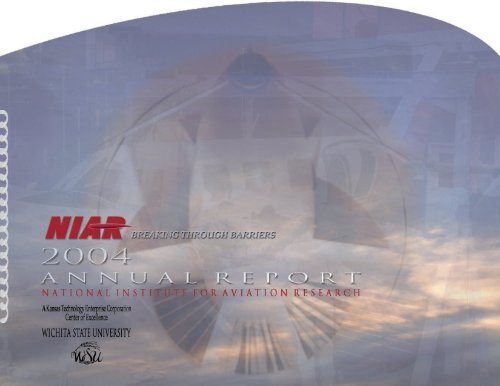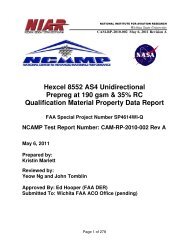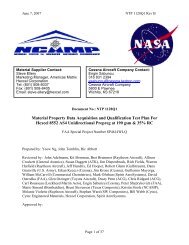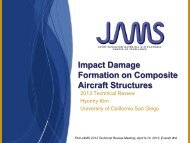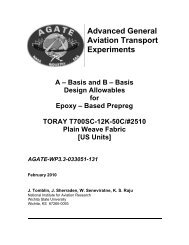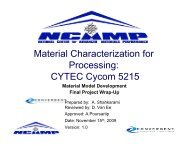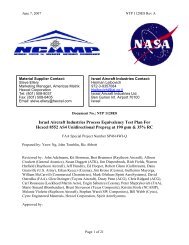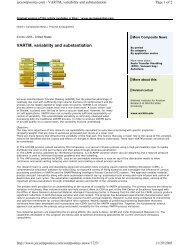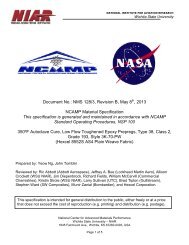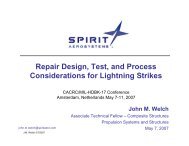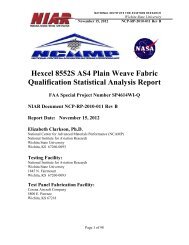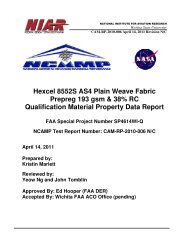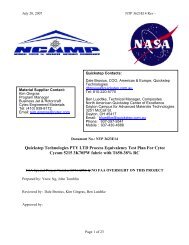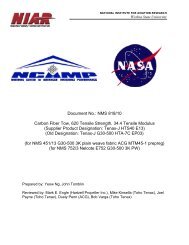Download - National Institute for Aviation Research - Wichita State ...
Download - National Institute for Aviation Research - Wichita State ...
Download - National Institute for Aviation Research - Wichita State ...
You also want an ePaper? Increase the reach of your titles
YUMPU automatically turns print PDFs into web optimized ePapers that Google loves.
To conduct research,<br />
transfer technology and<br />
enhance education<br />
<strong>for</strong> the purpose of<br />
advancing the nation’s<br />
aviation industries that<br />
may benefit from<br />
aviation related<br />
technologies.<br />
Located on the <strong>Wichita</strong> <strong>State</strong> University campus, in a city recognized as the Air<br />
Capital of the World, NIAR integrates university, government and business entities<br />
in cooperative ef<strong>for</strong>ts to advance technologies <strong>for</strong> aviation and other industries. Our<br />
120,000 square foot facilities are recognized internationally as a high-tech research<br />
and development, testing, certification and learning center.<br />
<strong>Aviation</strong> has been in the <strong>Wichita</strong> community <strong>for</strong> many years, and since 1984, NIAR<br />
has been its pulse. Since that time, we have made a name <strong>for</strong> ourselves as one of the<br />
few state-of-the-art aviation research centers in the United <strong>State</strong>s recognized <strong>for</strong> our<br />
contributions to aviation safety and per<strong>for</strong>mance.<br />
As you explore our annual report, you will see that our role in the revamping of<br />
aircra design and manufacturing will help the aviation industry meet their goal of<br />
making the skies friendlier and more cost-efficient.<br />
N A T I O N A L I N S T I T U T E F O R A V I A T I O N R E S E A R C H
Executive Director’s Message<br />
Funding Sources<br />
Year in Review<br />
Organizational Structure<br />
Laboratories<br />
Aerodynamics<br />
Aging Aircra<br />
Aircra Icing<br />
Composites & Advanced Materials<br />
Crash Dynamics<br />
Ergonomics<br />
Fatigue & Fracture<br />
Full-Scale Structural Testing<br />
Human Factors<br />
Structures<br />
Virtual Reality<br />
CAD/CAM<br />
<strong>Research</strong> Machine Shop<br />
Visual Technology<br />
Centers of Excellence<br />
AACE<br />
CECAM<br />
CGAR<br />
NCAMP<br />
<strong>Research</strong> Programs<br />
ADMRC<br />
NIAR~Industry~<strong>State</strong> (NIS)<br />
Resources<br />
Team & Facility<br />
MAMTC & SBDC<br />
Clients<br />
Contact Us<br />
2<br />
3<br />
4-5<br />
6<br />
7-20<br />
21-24<br />
25-26<br />
27-29<br />
30<br />
N A T I O N A L I N S T I T U T E F O R A V I A T I O N R E S E A R C H
Dear Colleagues:<br />
The past year at the <strong>National</strong> <strong>Institute</strong> <strong>for</strong> <strong>Aviation</strong> <strong>Research</strong><br />
(NIAR) has been one of discovery and unparalleled<br />
progress. As the theme of our annual report indicates, we<br />
have broken through many barriers and shown that the<br />
combination of academia, industry and government can<br />
produce a true state-of-the-art aviation research facility.<br />
This collaboration has generated exciting renovations in<br />
two of our major laboratories and resulted in an innovative<br />
technology partnership that has greatly expanded our<br />
testing and research capabilities.<br />
The Walter H. Beech Memorial Wind Tunnel underwent its<br />
first major renovation since its creation in 1949. The tunnel<br />
provides users with critical testing important to aircraft<br />
design and, although it has experienced small updates<br />
in the past, this major upgrade focused on the principal<br />
components resulting in a significantly improved facility.<br />
As this tunnel becomes operational and begins per<strong>for</strong>ming<br />
<strong>for</strong> the industry, Kansas and <strong>Wichita</strong> will become known<br />
as the location of the premier low-speed wind tunnel of its<br />
category in the nation. The second laboratory upgrade was<br />
the replacement of our horizontal crash system in the Crash<br />
Dynamics Laboratory. This upgrade and expansion gives<br />
NIAR the ability to become a world leader in the continual<br />
evolution of dynamic test requirements <strong>for</strong> aircraft<br />
occupant protection systems, as well as advanced systems<br />
<strong>for</strong> automotive applications. Both of these upgrades were<br />
made possible with state and federal support through the<br />
continued backing of NIAR by the Kansas <strong>State</strong> Legislature,<br />
KTEC, and the Kansas congressional delegations.<br />
NIAR and WSU also embarked upon another enterprise in<br />
establishing the Aircraft Structural Testing and Evaluation<br />
Center. The center was created as part of an agreement<br />
with Raytheon Aircraft Company in which the <strong>Institute</strong> has<br />
occupied and is supplying testing services in the Full-Scale<br />
Structural Testing Laboratory at Raytheon’s manufacturing<br />
campus in <strong>Wichita</strong>, Kansas. Included in the center are<br />
46,000 square feet of hangar space, access to an 8,000-<br />
foot runway and approximately $10 million in reliable test<br />
equipment. This laboratory strengthens NIAR’s structural<br />
testing and aircraft evaluation capabilities and allows us<br />
to offer expanded services to all aviation manufacturers<br />
and designers from around the world who utilize our<br />
research team. In addition to the acquired facilities, NIAR<br />
also gained 18 additional full-time staff members whose<br />
expertise in structural testing exceeds 300 years, making<br />
the laboratory one of the most experienced structural<br />
testing centers in the world.<br />
The benefits gained from relationships such as these have led<br />
to the creation of centers of excellence, and this year provided<br />
two such examples. In 2004, we were proud to announce the<br />
establishment of two advanced materials-related centers of<br />
excellence sponsored and supported by the Federal <strong>Aviation</strong><br />
Administration (FAA) and the <strong>National</strong> Aeronautics<br />
and Space Administration (NASA). The FAA Center<br />
of Excellence <strong>for</strong> Composites and Advanced Materials<br />
(CECAM) and the NASA <strong>National</strong> Center <strong>for</strong> Advanced<br />
Materials Per<strong>for</strong>mance (NCAMP) work together to promote<br />
technology integration that will achieve significant cost<br />
and cycle-time reductions in new material insertion as well<br />
as conducting basic and applied research within specific<br />
technology areas. These centers also facilitate growth in the<br />
use of advanced materials while supporting the safety and<br />
certification issues involved in airworthiness assurance.<br />
The combination of these centers will benefit the aircraft<br />
industry in both advanced research and the demonstration<br />
of cost savings in advanced materials applications.<br />
As NIAR looks to the future, support from federal and state<br />
governments is essential in helping the aviation industry<br />
remain competitive in the world market. This support<br />
will assist in the establishment of the Advanced Joining<br />
Laboratory during CY 2005, which allows the joining of<br />
aerodynamic structures without rivets, and will build the<br />
world’s 4th largest icing research facility at NIAR.<br />
As advances in aircraft development will likely accelerate<br />
during the next decade, new emerging technologies will be<br />
applied to design and placed into production throughout<br />
the industry. Because of the close cooperative partnership<br />
of industry, government and academia, NIAR will continue<br />
to break through more barriers in its mission of conducting<br />
research, transferring technology and enhancing education<br />
directed toward the support of the nation’s aviation and<br />
non-aviation industries.<br />
Please visit our website at www.niar.wichita.edu <strong>for</strong><br />
additional in<strong>for</strong>mation about our capabilities and resources.<br />
Sincerely,<br />
John S. Tomblin, PhD<br />
Executive Director, NIAR<br />
Sam Bloomfield Distinguished<br />
Professor of Aerospace Engineering<br />
4<br />
N A T I O N A L I N S T I T U T E F O R A V I A T I O N R E S E A R C H
FUNDING SOURCES<br />
Funding: New and Carry-over<br />
FY 2004<br />
$20,719,415<br />
Private<br />
2.8%<br />
$588,700<br />
<strong>State</strong>/KTEC/University<br />
13.6%<br />
$2,869,680<br />
Industry<br />
12.7%<br />
$2,636,358<br />
In addition to funding received through grants and contracts, NIAR<br />
appreciates the continued support from the state legislature and our<br />
congressional delegation. The interest and support of Senators Roberts<br />
and Brownback and Congressman Tiahrt have been especially helpful.<br />
Federal Grants<br />
and Contracts<br />
70.6%<br />
$14,624,677<br />
5<br />
N A T I O N A L I N S T I T U T E F O R A V I A T I O N R E S E A R C H
6<br />
N A T I O N A L I N S T I T U T E F O R A V I A T I O N R E S E A R C H
N A T I O N A L I N S T I T U T E F O R A V I A T I O N R E S E A R C H<br />
7
ORGANIZATIONAL STRUCTURE<br />
8<br />
N A T I O N A L I N S T I T U T E F O R A V I A T I O N R E S E A R C H
AERODYNAMICS<br />
AERODYNAMICS ENCOMPASSES FOUR WIND TUNNELS AND ONE WATER TUNNEL.<br />
EACH PROVIDES PRIVATE INDUSTRY, GOVERNMENT AND EDUCATIONAL INSTITUTIONS<br />
THE TOOLS NEEDED TO MAKE OUR LIVES SAFER AND MORE EFFICIENT.<br />
A n n u a l S u m m a ry<br />
It has been quite a year <strong>for</strong> the Aerodynamic Laboratories, which<br />
incorporates the Walter H. Beech Memorial Wind Tunnel and the Flow<br />
Visualization Lab. Beginning last October, the wind tunnel underwent a<br />
$6 million upgrade. The following equipment was replaced as part of the<br />
upgrade:<br />
• 2,500 horsepower fan<br />
• Heat exchanger<br />
• Flow conditioning equipment<br />
• External balance<br />
Airspeeds in excess of 230 mph have been observed with test section<br />
temperature below 95 degrees. Prior to the upgrades, the tunnel’s speed<br />
was confined to approximately 150 mph winds and its temperature could<br />
rise above 150 degrees.<br />
These improvements have established the tunnel as the state-of-the-art<br />
wind tunnel of its class in North America.<br />
The water tunnel has greatly expanded its testing areas with the addition<br />
of the following:<br />
• Modern photo, video and lighting equipment<br />
• Force measurement apparatus<br />
• Survey probe<br />
These upgrades have increased the labs capacity and enabled it to<br />
expand beyond flow visualization to measuring <strong>for</strong>ces and survey wakes of<br />
models.<br />
In the coming year, the Aerodynamics staff will bring the two labs into<br />
full operation, while polishing and perfecting their proficiency with the<br />
new systems. The staff is also in the early stages of implementing new<br />
technologies that will take the labs usability to a new level…stay tuned.<br />
Sco Miller, PhD<br />
Technical Director<br />
(316) 978-6334<br />
sco.miller@wichita.edu<br />
John Laffen<br />
Director<br />
(316) 978-3569<br />
john.laffen@wichita.edu<br />
9<br />
N A T I O N A L I N S T I T U T E F O R A V I A T I O N R E S E A R C H
AGING AIRCRAFT<br />
AS THE AGE OF OUR FLEETS APPROACHES A POINT OF CRITICALITY, THE NEED FOR AGING<br />
STUDIES BECOMES MORE PREVALENT. THE AGING AIRCRAFT LAB, SIMILAR TO A FORENSICS<br />
LAB, IS EQUIPPED TO HANDLE A VARIETY OF INVESTIGATIONS INTO OUR MATURING FLEET.<br />
A n n u a l S u m m a ry<br />
Over the last year, the Aging Aircra Lab has greatly expanded its<br />
capabilities with its relocation to the Aircra Structural Testing and<br />
Evaluation Center (ASTEC) at Raytheon Aircra Co. This relocation allows<br />
the lab to take on full-scale investigations into industry’s growing fleet of<br />
aging aircra.<br />
As the age of our military and commercial fleets increases, the need to<br />
provide industry with in<strong>for</strong>mation about the consequences of aging<br />
aircra becomes more prevalent. With this in mind, the Aging Aircra Lab<br />
has conducted numerous studies on some of the world’s most sought-aer<br />
and well-known aircra. Over the last two years, the lab has been engaged<br />
in several research projects:<br />
• FAA teardown evaluation: Piper Navajo and Beechcra 1900D<br />
• B-52 wing sections<br />
• B-52 flight control and landing gear assemblies<br />
• C-5A major structural components<br />
• C-130 center wing section<br />
• F-16C static test article<br />
2004 Projects:<br />
<strong>Research</strong>: Completed aging studies <strong>for</strong> the FAA on two small commuter<br />
aircra, the Cessna 402A and 402C.<br />
Objective: Provide insight into the condition of a typical aged airplane<br />
and to determine whether a correlation exists between maintenance<br />
history and current condition from a safety of flight perspective.<br />
<strong>Research</strong>: Conducted a comprehensive teardown and inspection on<br />
B-52 wing sections and major structural components on the C-5A<br />
aircra.<br />
Objective: To find any unexpected damage in inaccessible areas and<br />
examine areas with expected damage and confirm the extent of the<br />
damage.<br />
<strong>Research</strong>: Conducted detailed disassembly and inspection of flight<br />
control and landing gear assemblies from a retired B-52G aircra.<br />
Objective: To determine condition of components and develop overhaul<br />
procedure <strong>for</strong> replacement of assemblies on active B-52H aircra.<br />
05’ <strong>Research</strong>: Programs will continue <strong>for</strong> the FAA, B-52 and C-5A with<br />
additional teardown and inspections proposed on C-130 and F-16<br />
aircra.<br />
Dale Cope, PhD<br />
Director<br />
(316) 978-3204<br />
dale.cope@wichita.edu<br />
Melinda Laubach<br />
Manager<br />
(316) 978-8205<br />
melinda.laubach@wichita.edu<br />
10<br />
N A T I O N A L I N S T I T U T E F O R A V I A T I O N R E S E A R C H
AIRCRAFT ICING<br />
AS ONE OF THE LEADING UNIVERSITIES ENGAGED IN AVIATION ICING<br />
RESEARCH, NIAR’S AIRCRAFT ICING LAB RESEARCH DIRECTLY RELATES<br />
TO THE WORLD’S MOST DETRIMENTAL ICING CONDITIONS.<br />
A n n u a l S u m m a ry<br />
Icing research is an issue pertinent in all areas of aviation because it is<br />
a hazard on many levels. As one of the nation’s leading universities in<br />
aircra icing research, the goal of NIAR’s Aircra Icing <strong>Research</strong> Center is<br />
to conduct research that will contribute to the worldwide ef<strong>for</strong>t to reduce<br />
icing-related accidents.<br />
As part of this continued ef<strong>for</strong>t, the center has established a working<br />
relationship with U.S., Canadian and European governments and<br />
universities.<br />
It is through these relationships that NIAR is capable of maintaining its<br />
reputation in the icing industry and conducting a variety of research that<br />
will keep aircra safe.<br />
2004 Projects:<br />
<strong>Research</strong>: Compilation of Experimental Water Droplet Impingement<br />
Data Obtained by WSU – FAA<br />
Objective: Development of an electronic database of all the impingement<br />
data obtained during six IRT entries (1985, 1989, 1997, 1999, 2001 and 2003).<br />
<strong>Research</strong>: Experimental Investigation of Hot-Air Ice Protection Systems; NASA<br />
Objective: Generate an extensive thermal database <strong>for</strong> code development<br />
and validation and to support the design of hot-air ice protection systems<br />
and develop a high precision wind tunnel model equipped with a<br />
hot-air ice protection system <strong>for</strong> testing in a large icing tunnel facility.<br />
<strong>Research</strong>: SLD Impingement on Ice Shapes; FAA<br />
Objective: Generate an experimental database of small and large<br />
droplet impingement on progressively larger LEWICE ice shapes <strong>for</strong> the<br />
validation of trajectory codes used in aircra icing analyses.<br />
<strong>Research</strong>: Simulated Icing Test Nozzle Design and Feasibility Study; NIS<br />
Objective: Development of airborne spray systems capable of simulating<br />
SLD as well as Appendix C icing conditions.<br />
<strong>Research</strong>: Development of a Reference LWC probe <strong>for</strong> Appendix C and<br />
SLD Conditions; FAA<br />
Objective: Ensure that reliable measurements of LWC in icing tunnels<br />
can be obtained <strong>for</strong> SLD conditions.<br />
<strong>Research</strong>: Computational Study of Large Droplet Dynamics in the<br />
Vicinity of an Airfoil; FAA<br />
Objective: To conduct a complete literature review of droplet breakup<br />
studies and per<strong>for</strong>m two-dimensional numerical simulations of small<br />
and large droplet breakup in the proximity of airfoils in support of<br />
future research to develop experimental data and simulation tools.<br />
<strong>Research</strong>: Test Methods and Visualization Tools <strong>for</strong> Large Droplet<br />
Dynamics Experiments; NASA<br />
Objective: To develop visualization method <strong>for</strong> investigating droplet<br />
splashing from an ice shape in a wind tunnel. This project will address<br />
the development of new or re-defined visualization methods that can<br />
provide quantitative in<strong>for</strong>mation on the splashed droplet size, velocity<br />
and concentration in the future.<br />
<strong>Research</strong>: Ice Particle Trajectory Program - ADMRC/NASA<br />
Objective: To develop experimental and computational methodologies<br />
<strong>for</strong> determining the trajectories of ice particles shed from aircra<br />
surfaces during icing encounters. The end goal will be the development<br />
of a simulation tool <strong>for</strong> use in aircra icing certification.<br />
Michael Papadakis, PhD<br />
Director<br />
(316) 978-3307<br />
michael.papadakis@wichita.edu<br />
11<br />
N A T I O N A L I N S T I T U T E F O R A V I A T I O N R E S E A R C H
COMPOSITES & ADVANCED MATERIALS<br />
THE RESEARCH CONDUCTED IN THIS LAB PROVIDES INDUSTRY<br />
WITH INFORMATION ON HOW COMPOSITES & ADVANCED MATERIALS<br />
BEHAVE IN CERTAIN CONDITIONS, SUCH AS HEAT AND MOISTURE.<br />
A n n u a l S u m m a ry<br />
Over the past year, the Composites and Advanced Materials Lab has begun<br />
work with NIAR’s two newly established centers in advanced materials – the<br />
FAA Center of Excellence in Composites and Advanced Materials (CECAM)<br />
and the NASA <strong>National</strong> Center <strong>for</strong> Advanced Materials Per<strong>for</strong>mance<br />
(NCAMP). These centers provide the backbone of the research thrusts of the<br />
lab and provide support to the aircra industry.<br />
The lab has experienced some significant developments during the past year:<br />
• Staff size has increased by approximately 75 percent; presently there<br />
are 7 full-time managers, 12 full-time engineering support staff and 46<br />
undergraduate/graduate students working within the lab.<br />
• Supported development and material characterization ef<strong>for</strong>ts of<br />
approximately 42 aerospace and non-aerospace related companies. These<br />
ef<strong>for</strong>ts included non-metallic as well as metallic advanced materials.<br />
• Capability increased by the addition of a multi-axis ultrasonic inspection<br />
unit, scanning electron microscope, additional layup facilities,<br />
environmental chambers, thermal analysis equipment and various<br />
machining and measurement equipment.<br />
• Published several FAA technical reports related to adhesive bonding,<br />
damage tolerance and material and process specification guidelines <strong>for</strong><br />
composites.<br />
• Sponsored two FAA workshops related to material and process<br />
specifications <strong>for</strong> liquid resin molding and adhesive bonding. These<br />
workshops were held in Chicago, IL and Seale, WA, respectively.<br />
<strong>Research</strong>: Aging of Composite Aircra Structures<br />
Objective: Investigate the aging aspects of composite, non-metallic<br />
structures which possess actual age and service history and provide<br />
airworthiness assurance of these composite components. These<br />
investigations will use a decommissioned 737 horizontal stabilizer and a<br />
Beechcra Starship <strong>for</strong> the research.<br />
<strong>Research</strong>: Adhesive Characterization and Element Testing of Fatigued and<br />
Damaged Bonded Joints.<br />
Objective: Identify characteristic responses of bonded structures to real<br />
world manufacturing and repair defects. The work will also establish<br />
guidelines <strong>for</strong> adhesive and process controls <strong>for</strong> bonded structures.<br />
<strong>Research</strong>: Seat Cushion Component Test Validation<br />
Objective: To develop and validate a component test method that can be<br />
used to certify cushions <strong>for</strong> 16-g seats. This investigation used a high-rate<br />
test machine on a wide variety of flotation and non-flotation materials<br />
developed <strong>for</strong> seat cushion component replacement.<br />
<strong>Research</strong>: Full-Scale Fuselage Testing and Damage Tolerance<br />
Objective: The development of the complete understanding of a number<br />
of characteristics of damage states of sandwich composites. This requires<br />
a full-scale test to assure that the conclusion drawn from the lower level<br />
testing applies at the full-scale level.<br />
John Tomblin, PhD<br />
Director<br />
(316) 978-5234<br />
john.tomblin@wichita.edu<br />
Janna Sherraden<br />
<strong>Research</strong> Specialist<br />
(316) 978-5235<br />
janna.sherraden@wichita.edu<br />
12<br />
2004 Projects:<br />
<strong>Research</strong>: Repair of Composite Aircra Structures<br />
Objective: Answer not only the fundamental questions related to the proper<br />
repair methods/systems required to restore the aircra part structural<br />
integrity, but also the question of how long the repair will last under the<br />
specified design conditions and what are the most critical factors affecting<br />
the static per<strong>for</strong>mance and the long-term durability of the repair.<br />
<strong>Research</strong>: Design Philosophies <strong>for</strong> Structures Utilizing Metal and<br />
Composites with Large CTE Differences<br />
Objective: Develop design data and design philosophies <strong>for</strong> accommodation<br />
of thermal effects within large aircra composite/metallic assemblies.<br />
N A T I O N A L I N S T I T U T E F O R A V I A T I O N R E S E A R C H
CRASH DYNAMICS<br />
THE CRASH DYNAMICS LAB HAS THE CAPABILITIES TO CONDUCT<br />
COST-EFFICIENT, SECURE AND PROPRIETARY TESTING FOR THE<br />
AVIATION AND AUTOMOTIVE INDUSTRY.<br />
A n n u a l S u m m a ry<br />
Lights, camera, action aren’t three words you would typically hear when<br />
thinking about a crash lab, but they are three of the most important<br />
components of the research that help determine what happens during<br />
a crash. It is the mission of the Crash Dynamics Lab to provide the<br />
highest level of professional testing services to its various clients and<br />
constituents.<br />
In keeping with that philosophy, the Crash Dynamics Lab undertook a<br />
major systems renovation that raises the bar <strong>for</strong> its mission statement<br />
of providing clients with a state-of-the-art service center replete with<br />
technologically advanced test equipment to aid in the research, design,<br />
testing and certification of occupant protection systems.<br />
The Crash Dynamics Lab is also capable of replicating any crash pulse upon<br />
a wide range of surrogate occupants, provide visual documentation of the<br />
crash simulation through high-speed, high-resolution color imagery and<br />
within minutes, present the video and instrumentation data <strong>for</strong> analysis.<br />
This is all possible since the addition of the following upgrades:<br />
MTS Model 888.20 Crash Simulator capable of replicating a wide range<br />
of crash pulses of amplitudes up to 75 g.<br />
High-resolution (1536x1024 pixels), high-speed (up to 10,000 frames per<br />
minute) video cameras capable of operating both on and off the sled and<br />
of immediate playback of the crash simulation.<br />
Wide range of surrogate occupants to include Hybrid II 50th, Hybrid<br />
III FAA 50th, Hybrid III 50th (NHTSA), Hybrid III 95th, and a EuroSID<br />
II. The near future will see an expanded family of surrogates that will<br />
include the Hybrid III 5th Female and a range of infant and adolescent<br />
surrogates.<br />
Data Acquisition System capable of sampling rates up to 50K samples<br />
per second per channel. Immediate download of data <strong>for</strong> signal<br />
conditioning, post-processing and presentation.<br />
Joseph Mitchell<br />
Director<br />
(316) 978-5239<br />
joseph.mitchell@wichita.edu<br />
13<br />
N A T I O N A L I N S T I T U T E F O R A V I A T I O N R E S E A R C H
ERGONOMICS<br />
THROUGH RESEARCH, THE ERGONOMICS AND OCCUPATIONAL BIOMECHANICS<br />
LAB IS CAPABLE OF EDUCATING BUSINESSES AND INDIVIDUALS ON HOW THEY<br />
CAN REDUCE PAIN AND INJURIES ASSOCIATED WITH WORK.<br />
A n n u a l S u m m a ry<br />
During the past year the Ergonomics Lab has per<strong>for</strong>med research in many<br />
different and diverse areas, all relating to the human body at work.<br />
The effect of aging on the human body and its capabilities continues to<br />
be important from a functional and occupational standpoint. One of the<br />
areas addressed was the body’s reaction to exposure of vibration in an<br />
occupational seing. This area was investigated in the field seing during<br />
the use of heavy mobile construction equipment, as well as the vibration<br />
experienced in the upper extremity when riveting and using bucking bars<br />
in the aircra manufacturing industry.<br />
The lab has also continued to investigate muscle size aspects of the human<br />
body through magnetic resonance imaging, in addition to investigating<br />
the different design aspects of computer mouse input devices. Finally, the<br />
lab has initiated and will continue to per<strong>for</strong>m workplace research on the<br />
practice of utilizing job rotation in a manufacturing seing in an ef<strong>for</strong>t to<br />
reduce occupational injuries.<br />
2004 Projects:<br />
<strong>Research</strong>: Balance of Elderly Independent Living Residents<br />
Objective: Quantify balance and sway of independent living residents<br />
to identify measures <strong>for</strong> prediction of risk of falls.<br />
<strong>Research</strong>: Low Back Pain and Mobile Construction Equipment<br />
Objective: Investigate the effect of a passive cyclic lumbar seat support<br />
on low back discom<strong>for</strong>t during the operation of large mobile construction<br />
equipment.<br />
<strong>Research</strong>: Job Rotation in the Manufacturing Sector<br />
Objective: Determine the prevalence of use and objectives and benefits<br />
of job rotation.<br />
<strong>Research</strong>: Ergonomic Assessment of Riveting and use of Bucking Bars<br />
Objective: Quantify the difference in grip <strong>for</strong>ce and vibration<br />
transmission to the hands of bucking bars of different materials <strong>for</strong><br />
aircra riveting.<br />
<strong>Research</strong>: Torso Muscle Quantification <strong>for</strong> Biomechanical Modeling<br />
Objective: Quantify the distance of the female rectus abdominis muscle<br />
from the spine in an upright standing posture, compared to that from<br />
lying supine.<br />
<strong>Research</strong>: Ergonomic Assessment of Five Different Computer Input Devices<br />
Objective: Quantify the shoulder and <strong>for</strong>earm muscle activity and<br />
posture when using different mouse designs <strong>for</strong> computer input.<br />
Michael Jorgensen, PhD<br />
NIAR Fellow<br />
(316) 978-5904<br />
michael.jorgensen@wichita.edu<br />
14<br />
N A T I O N A L I N S T I T U T E F O R A V I A T I O N R E S E A R C H
FATIGUE & FRACTURE<br />
THE FATIGUE AND FRACTURE LAB SPECIALIZES IN ENDURANCE TESTING OF<br />
MATERIALS SUBJECTED TO FATIGUE DAMAGE DUE TO CYCLIC LOADING. THE GOAL<br />
OF THIS TESTING IS TO DEVELOP DATA AND METHODOLOGIES FOR THE DURABILITY<br />
AND DAMAGE OF MATERIALS, SUCH AS COMPOSITES AND METALLICS.<br />
A n n u a l S u m m a ry<br />
Since the creation of the Fatigue & Fracture Lab in November 2003, it has<br />
seen tremendous growth. The lab currently houses 15 servo-hydraulic load<br />
frames <strong>for</strong> durability and damage tolerance testing along with advanced<br />
equipment <strong>for</strong> monitoring crack growth and compliance changes in both<br />
metallic and non-metallic materials.<br />
The mission of the Fatigue and Fracture Lab is to test the endurance of<br />
materials subjected to fatigue under cyclic loading. Fatigue experiments are<br />
conducted to generate S-N curves and/or fatigue crack propagation data<br />
to help assess the fatigue characteristics of materials to be used in metal<br />
and composite structures or to quantify fatigue damage accumulation and<br />
residual fatigue life in older aircra.<br />
2004 Projects:<br />
<strong>Research</strong>: Data and Methodologies <strong>for</strong> Structural Life Evaluation of<br />
Small Airplanes<br />
Objective: To develop a structural fatigue life evaluation methodology<br />
<strong>for</strong> small airplanes. The methodology provides a direct approach that<br />
takes into consideration individual structural details and full-scale<br />
structural complexities to generate an effective stress concentration<br />
factor.<br />
<strong>Research</strong>: Friction Stir Welding of Aluminum Alloys<br />
Objective: Friction stir welding is a relatively new process to weld<br />
aluminum. The static, fatigue & fracture properties along with the<br />
effects of corrosion on the weld nugget are being investigated <strong>for</strong> several<br />
Al alloys used by the aircra industry.<br />
<strong>Research</strong>: Fatigue Crack Growth Testing to Quantify the Effects of Shot<br />
Peening <strong>for</strong> Metallic Rotorcra Components<br />
Objective: To support the FAA in extending the rotorcra damage<br />
tolerance (RCDT) methodology to apply to rotorcra components in<br />
which shot peening or other surface treatments have been made to<br />
suppress fatigue crack growth (FCG).<br />
<strong>Research</strong>: Fabrication, Testing and Analysis of Carbon/Glass Hybrid<br />
Composites<br />
Objective: To fabricate, test and analyze anisotropic hybrid laminate<br />
configurations, representative of laminates used in wind turbine blade<br />
applications, manufactured using a vacuum-assisted resin transfer<br />
molding process.<br />
<strong>Research</strong>: Effects of Dents on Fatigue Life of Aluminum Alloys<br />
Objective: To investigate the effect on fatigue life and crack growth<br />
of the dents and processes to rework the dents commonly used by the<br />
aircra industry.<br />
James Locke, PhD<br />
Director<br />
(316) 978-6427<br />
james.locke@wichita.edu<br />
Brijesh Kumar<br />
<strong>Research</strong> Scientist<br />
(316) 978-6139<br />
brijesh.kumar@wichita.edu<br />
Lamia Salah<br />
<strong>Research</strong> Associate<br />
(316) 978-5775<br />
lamia.salah@wichita.edu<br />
15<br />
N A T I O N A L I N S T I T U T E F O R A V I A T I O N R E S E A R C H
FULL -SCALE S TRUCTURAL<br />
WHILE MOST ANALYTICAL TOOLS ARE UNABLE TO PREDICT A STRUCTURE’S REACTION TO<br />
LOADING AND ENVIRONMENTAL CONDITIONS , THE TESTING CENTER CAN ASSESS STRUCTURAL<br />
PERFORMANCE AND DURABILITY BY PERFORMING FULL-SCALE STATIC AND FATIGUE TESTS.<br />
A n n u a l S u m m a ry<br />
In an innovative technology arrangement between industry and academia,<br />
the <strong>National</strong> <strong>Institute</strong> <strong>for</strong> <strong>Aviation</strong> <strong>Research</strong> has obtained the Full-Scale<br />
Structural Testing Lab located at Raytheon Aircra’s manufacturing<br />
campus in <strong>Wichita</strong>, Kan. The arrangement was announced on Sept. 24,<br />
2004, with the occupation beginning immediately.<br />
This lab is the <strong>Institute</strong>’s Aircra Structural Testing and Evaluation Center<br />
(ASTEC), which provides research and testing services to other aircra<br />
manufacturers as well as governmental agencies.<br />
Included in the Aircra Structural Testing and Evaluation Center are:<br />
• 46,000 square feet of hangar space<br />
• Access to an 8,000-foot runway<br />
• Approximately $10 million in reliable test equipment<br />
Raytheon Aircra was the <strong>Institute</strong>’s launch customer. The lab provides<br />
structural testing <strong>for</strong> Raytheon Aircra’s entire product range, including<br />
current work on the Hawker Horizon fatigue and static tests.<br />
With these additional substantial test facilities from Raytheon Aircra,<br />
NIAR’s structural testing and aircra evaluation capabilities are<br />
strengthened. The <strong>Institute</strong> now offers expanded services to the leading<br />
aviation manufacturers and designers from around the world who utilize<br />
the NIAR research team.<br />
The innovative arrangement allows NIAR to establish a national center <strong>for</strong><br />
full-scale testing services to the broader aviation community.<br />
Focus Areas:<br />
Full-Scale and Component Testing, such as static, durability and<br />
damage tolerance testing<br />
Pressure Cyclic Testing<br />
Hail Strike Testing<br />
Drop Tower <strong>for</strong> Landing Gear Testing<br />
Coupon Test Lab<br />
Aircra and Component Instrumentation Lab<br />
Tireburst/Explosive Effects<br />
Tim Hickey<br />
Director<br />
(316) 978-8204<br />
tim.hickey@wichita.edu<br />
16<br />
N A T I O N A L I N S T I T U T E F O R A V I A T I O N R E S E A R C H
HUMAN FACTORS<br />
SPECIALIZING IN UNDERSTANDING COGNITIVE AND PERCEPTUAL<br />
PROCESSES, THE HUMAN FACTORS LAB HELPS OPTIMIZE THE<br />
PERFORMANCE OF HUMANS IN OPERATING COMPLEX SYSTEMS.<br />
A n n u a l S u m m a ry<br />
By studying how humans accomplish work-related tasks, the Human<br />
Factors Lab is capable of applying knowledge of a person’s sensory and<br />
cognitive processes to the design of products and systems. Through this<br />
relationship, businesses and individuals learn more about how certain<br />
tasks are accomplished and how they can be improved.<br />
Over the past year, the lab has continued to work with the aviation industry<br />
and local businesses on how to improve their efficiency.<br />
Specifically, in 2004, the lab continued its work with aviation technical<br />
writing groups at four aircra manufacturers to research ways in which<br />
reliability of maintenance documentation may be improved. Also in 2004,<br />
two FAA-funded projects have been completed, three are near completion,<br />
and two are scheduled <strong>for</strong> completion in fall 2005.<br />
Focus Areas:<br />
• <strong>Aviation</strong> Maintenance<br />
• Pilot In<strong>for</strong>mation Management<br />
• Multi-Tasking Per<strong>for</strong>mance<br />
Completed FAA Projects <strong>for</strong> 2004<br />
<strong>Research</strong>: A Comparison of Two Evaluative Techniques <strong>for</strong> Validating<br />
Maintenance Documentation.<br />
Objective: To compare techniques that manufacturers can use to<br />
improve the quality of the maintenance documentation developed by<br />
technical writing groups.<br />
<strong>Research</strong>: Evaluation Toolbox <strong>for</strong> <strong>Aviation</strong> Technical Writers.<br />
Objective: To develop an aid <strong>for</strong> writers to evaluate the usability of<br />
aviation maintenance documentation -- from the initial development<br />
stage through the final pre-publication stage.<br />
Flight Training Completed Project <strong>for</strong> 2004<br />
<strong>Research</strong>: Review of the FAA/Industry Training Standards (FITS)<br />
Program: Program tasks, goals and pilot training initiatives<br />
Objective: To review the current state of research and technology<br />
needed to support the goals of the FITS program. This in<strong>for</strong>mation<br />
can be used by the FAA to identify research areas that would aid<br />
achievement of FITS’ goals.<br />
Alex Chaparro, Ph.D<br />
NIAR Fellow<br />
(316) 978-3038<br />
alex.chaparro@wichita.edu<br />
17<br />
N A T I O N A L I N S T I T U T E F O R A V I A T I O N R E S E A R C H
S TRUCTURES<br />
THE STRUCTURES LAB PROVIDES RESEARCH CAPABILITIES FOR TEST ARTICLES<br />
RANGING FROM MATERIAL COUPONS TO LARGE SCALE STRUCTURES. THE LAB IS<br />
DESIGNED TO CHARACTERIZE THE LOAD CARRYING CAPABILITY OF MATERIALS.<br />
A n n u a l S u m m a ry<br />
18<br />
Over the last year, the Structures Lab has expanded its capabilities<br />
by adding two additional ARAMIS photogrammetry full-field strain<br />
measurement systems with higher data acquisition capabilities and a laser<br />
extensometer <strong>for</strong> non-contact strain measurements. A custom designed<br />
600-kip structural test frame and a two 67-kip MTS electromechanical load<br />
frames were also added to strengthen test capabilities.<br />
The Structures Lab staff works with federal agencies as well as general<br />
aviation, commercial and military companies to conduct research on<br />
advanced materials. This facility is equipped with a variety of servohydraulic<br />
load frames to per<strong>for</strong>m static and spectrum fatigue tests in<br />
o o<br />
temperatures ranging from -100 F to 600 F. During the past year, numerous<br />
composite material qualifications were accomplished and a number of<br />
specialized test procedures were developed <strong>for</strong> various customers.<br />
2004 Projects:<br />
<strong>Research</strong>: Laminate Statistical Design Allowable Generation <strong>for</strong> Fiber<br />
Rein<strong>for</strong>ced Composite Materials<br />
Objective: Recommend a reduced laminate qualification test matrix and<br />
statistical methodology <strong>for</strong> inclusion into Military Handbook 17 and<br />
publish a FAA guideline and methodology document.<br />
<strong>Research</strong>: Damage Tolerance of Laminated Composites and Adhesive<br />
Joints<br />
Objective: Generate adhesive design allowables and effects of defects<br />
data <strong>for</strong> adhesive joints.<br />
<strong>Research</strong>: Design & Analysis <strong>for</strong> Braided Composite Material<br />
Objective: Generate design allowables <strong>for</strong> tri-axial braided composite<br />
and develop a design and analysis methodology <strong>for</strong> braided structures.<br />
<strong>Research</strong>: Crashworthiness of Composite Fuselage Structures<br />
Objective: Experimental investigation of the high-strain rate effects on<br />
the mechanical properties of laminated composites.<br />
<strong>Research</strong>: Review of the capabilities of Photogrammetry and Electronic<br />
Speckle Paern Interferometry (ESPI) technologies as non-destructive<br />
inspection (NDI) methods<br />
Objective: Assessment of measurement bounds and physical limits<br />
and of photogrammetry and ESPI methods and evaluation of these<br />
systems <strong>for</strong> detection of cracks and displacement/strains in metallic<br />
components.<br />
<strong>Research</strong>: Damage Tolerance of Notched Composite Sandwich Panels<br />
Objective: Experimental investigation of the scaling effects associated<br />
with notched tensile and compressive properties of composite sandwich<br />
structures.<br />
<strong>Research</strong>: Load Distributions in Laminated Composite Structures<br />
Subjected to Semi-Parasitic Acoustic Treatments<br />
Objective: Study of the strain distributions in per<strong>for</strong>ated laminates and<br />
sandwich panels subjected to uniaxial in-plane loads. Photogrammetry<br />
techniques were used to map the strain distributions in the per<strong>for</strong>ated<br />
sheets under loading.<br />
John Tomblin, PhD<br />
Director<br />
(316) 978-5234<br />
john.tomblin@wichita.edu<br />
Waruna Seneviratne<br />
<strong>Research</strong> Associate<br />
(316) 978-5232<br />
waruna.seneviratne@wichita.edu<br />
N A T I O N A L I N S T I T U T E F O R A V I A T I O N R E S E A R C H
VIRTUAL REALIT Y<br />
THE VIRTUAL REALITY CENTER ACTS AS A VISUALIZATION AND SIMULATION SYSTEM IN<br />
AREAS SUCH AS AIRCRAFT CONCEPTION, ENGINEERING AND MANUFACTURING PROCESSES.<br />
THE CENTER HOUSES FULLY AND SEMI-IMMERSIVE VISUALIZATION EQUIPMENT.<br />
A n n u a l S u m m a ry<br />
Since early 2003, the Virtual Reality Center (VRC) has steadily increased<br />
its capabilities with acquisition of several devices and customization<br />
of commercial soware which address conception to engineering to<br />
manufacturing phases in aircra development cycle.<br />
Throughout the past year the VRC has updated equipment and<br />
infrastructure. Infrastructure improvements include customization and<br />
fine-tuning soware integration of virtual reality input/output devices<br />
(head-mounted displays, motion trackers, gloves and sound system) and<br />
remote collaboration.<br />
2004 Projects:<br />
<strong>Research</strong>: Completed a comprehensive VR simulation involving WSU<br />
Psychology Dept. and Cessna.<br />
Objective: Evaluate level of effectiveness of VR in assembly and<br />
disassembly tasks by using PTC Division Reality.<br />
<strong>Research</strong>: Provided technical support and real-time database preparation<br />
<strong>for</strong> WSU Industrial Engineering Dept and Aerospace Dept. projects.<br />
Objective: Database simplification and VR visualization involving<br />
<strong>National</strong> Science Foundation projects.<br />
<strong>Research</strong>: Conducted tests to evaluate run-time systems and provided<br />
technical support to Cessna Virtual Reality Center.<br />
Objective: Evaluate & improve visualization per<strong>for</strong>mance in SGI Onyx<br />
servers to virtual prototyping design reviews using Dassault Systems<br />
Enovia DMU.<br />
Fernando Faria de Toledo<br />
Manager<br />
(316) 978-8333<br />
fernando.toledo@wichita.edu<br />
19<br />
N A T I O N A L I N S T I T U T E F O R A V I A T I O N R E S E A R C H
CAD/CAM<br />
ONE OF THE LARGEST UNIVERSITY-BASED TEACHING FACILITIES IN THE U.S., THE CAD/CAM LAB<br />
PROVIDES CURRENT CATIA® EDUCATION AND TECHNICAL SUPPORT FOR A VARIETY OF<br />
MECHANICAL AND ELECTRICAL CAD/CAM/EDI AND OTHER COMPUTER GRAPHICS APPLICATIONS.<br />
A n n u a l S u m m a ry<br />
In 2004, the CAD/CAM Lab provided 54 CATIA V5 courses to<br />
approximately 600 students. In addition, the lab provided on-site<br />
training to companies and has provided curriculum to a number of schools<br />
and companies. The lab continues to expand its curriculum by working<br />
on new courses and is starting to develop ENOVIA courses as well.<br />
On-site training provided to:<br />
• Rocketplane Limited Inc.<br />
• GKN Aerospace<br />
• Cessna<br />
• Boeing <strong>Wichita</strong><br />
On-site support provided to:<br />
• Cessna<br />
The CAD/CAM Lab offers a number of courses <strong>for</strong> industry employees<br />
and WSU students. Some of the classes offered include: CATIA V5 Part<br />
Design & Sketcher, Assembly Design, Draing, Wireframe & Surfaces,<br />
Fiing Simulation & Kinematics, Prismatic Machining, and Surface<br />
Machining.<br />
Courses in Development:<br />
• CATIA V5 Functional Tolerancing & Annotation<br />
• CATIA V5 Stress Analysis<br />
• ENOVIA Assembly<br />
Curriculum acquired by:<br />
Airbus North America<br />
Boeing <strong>Wichita</strong><br />
Boeing Corporate<br />
Cessna<br />
V5 Engineering<br />
ZTM Inc.<br />
Schoolcra College<br />
ITT Technical <strong>Institute</strong><br />
Global Engineering and Technology<br />
Shawn Ehrstein<br />
Associate Director<br />
(316) 978-5839<br />
shawn@cadcamlab.org<br />
20<br />
N A T I O N A L I N S T I T U T E F O R A V I A T I O N R E S E A R C H
RESEARCH MACHINE SHOP<br />
THE RESEARCH MACHINE SHOP HAS HAD A HISTORY OF SUCCESS; FROM THE CONSTRUCTION OF THE<br />
WALTER H. BEECH WIND TUNNEL IN 1946, TO THE BUILDING OF COMPOSITE TOOLS. AS INDUSTRY EVOLVES,<br />
THE SHOP CONTINUES TO BE A STATE-OF-THE-ART FACILITY CAPABLE OF MEETING INDUSTRY NEEDS.<br />
A n n u a l S u m m a ry<br />
Over the last year, the <strong>Research</strong> Machine Shop has continued working its<br />
magic providing quality machine shop support <strong>for</strong> research activity at<br />
WSU, NIAR and more.<br />
The shop has conducted a multitude of different research projects since<br />
its establishment in 1944. They aided in the construction of the first Walter<br />
H. Beech Wind Tunnel and played a similar role today in the tunnel’s first<br />
major upgrade.<br />
Beyond WSU and NIAR, the machine shop also takes on the needs of<br />
industry clients. The same is true <strong>for</strong> today; with many completed and<br />
ongoing projects aiding in the improvement of the aviation industry.<br />
2004 Projects:<br />
Designed and produced four wind tunnel models <strong>for</strong> research related<br />
to severe weather safety<br />
Machined several small projects <strong>for</strong> the WSU Chemistry department<br />
Machined parts to upgrade a machine <strong>for</strong> the NIAR Composites Lab<br />
Machined parts <strong>for</strong> a very large test frame designed to load to failure<br />
test panels provided by Boeing<br />
Worked several small projects to support Lightning Protection and<br />
Electro-magnetic <strong>Research</strong> <strong>for</strong> composite aircra<br />
Machined anti-buckling fixtures <strong>for</strong> materials testing<br />
Worked projects <strong>for</strong> research related to optimizing piccolo tube deicing<br />
systems <strong>for</strong> aircra<br />
Designed and modified a NACA 23012 model so it can be installed in the<br />
WSU wind tunnel <strong>for</strong> aircra icing research<br />
Made and/or modified several tools <strong>for</strong> Aging Aircra research<br />
Provided support <strong>for</strong> Friction Stir Welding research<br />
Provided support <strong>for</strong> the major upgrade of the WSU wind tunnel<br />
Produced a <strong>for</strong>m die <strong>for</strong> Koch-Glitch Co.<br />
Art Porter<br />
Manager<br />
(316) 978-3656<br />
arthur.porter@wichita.edu<br />
21<br />
N A T I O N A L I N S T I T U T E F O R A V I A T I O N R E S E A R C H
VISUAL TECHNOLOGY<br />
THE VISUAL TECHNOLOGY LAB IS RESPONSIBLE FOR CREATING 3D<br />
MODELS, PRODUCING COMMERCIALS, ADVERTISING CAMPAIGNS AND<br />
PROMOTIONAL ANIMATIONS FOR WSU, NIAR AND LOCAL BUSINESSES.<br />
A n n u a l S u m m a ry<br />
The Visual Technology Lab (VTL) is the creative arm of the <strong>Institute</strong>. Their<br />
abilities led to the production of two animations that won them two Addy<br />
Awards from the Advertising Federation of <strong>Wichita</strong>. The VTL crew was<br />
honored with two “Best of Show” awards <strong>for</strong> their development of “Rally<br />
the Fans <strong>for</strong> WSU Basketball” and a commercial <strong>for</strong> Legacy Bank.<br />
Because the enrollment of 3D Camp! has nearly doubled over the last<br />
year, the lab has made a few substantial changes to the organization and<br />
requirements of the Maya classes they offer.<br />
2005 Fall semester modifications:<br />
• Semester long Maya classes split into one credit hour modules that will<br />
be five weeks long.<br />
• Introduction to Maya will be supplanted by: Introduction to 3D<br />
graphics, Modeling 1, and Animation 1<br />
• Introduction to Maya will be divided into: Modeling 2, Animation 2,<br />
and Lighting and Texturing.<br />
2004 Projects:<br />
Produced animated elements <strong>for</strong> a number of projects lead by the Media<br />
Resources Center, including graphic elements used in the play “Wings,”<br />
based on events that lead up to the Brown v Board of Education<br />
decision, and per<strong>for</strong>med on the anniversary of the decision in<br />
Topeka, Kansas<br />
Provided additional support graphics <strong>for</strong> the Athletic Department to be<br />
displayed on the Koch Arena Scoreboard<br />
Provided animation elements, the Target© dog, animated charts, store<br />
openings and more <strong>for</strong> Target, Inc.<br />
Created the animated gorilla used in TV ads announcing the new<br />
Downing Gorilla exhibit at the Sedgwick County Zoo<br />
Produced animated elements <strong>for</strong> the Downtown Arena “Vote Yeah”<br />
campaign<br />
Provided graphics <strong>for</strong> BG Products marketing communications<br />
Provided animation elements used in Feist Communications ads<br />
Bill Johnson<br />
Manager<br />
(316) 978-6812<br />
bill@cadcamlab.org<br />
22<br />
N A T I O N A L I N S T I T U T E F O R A V I A T I O N R E S E A R C H
AACE<br />
FA A A i rwo r t h i n e s s A s s u r a n c e C e n t e r o f E xc e l l e n c e<br />
AACE mission…to work in partnership with academia, industry and government<br />
to provide timely, cost-effective, validated, advanced technologies and a skilled<br />
work<strong>for</strong>ce to improve airworthiness assurance over the short, mid and long-term. It<br />
will maintain a repository of knowledge and build a talent pool which will improve<br />
aviation safety and strengthen the competitive position of the U.S. aviation industry.<br />
The FAA established the Airworthiness Assurance Center of Excellence (AACE) in<br />
September 1997. NIAR is a core member of AACE, along with 29 other universities.<br />
The AACE team is designed to address the full spectrum of research, from basic research<br />
through applied research, validation and technology transfer. This unique center has<br />
aracted research in the areas of aviation safety, including composites and advanced<br />
materials, crashworthiness, icing, aging aircra and many more.<br />
2004 Projects:<br />
Testing Full-Scale Composite Sandwich Fuselage Panels<br />
Adhesive Characterization and Element Testing of Fatigued and Damaged Bonded Joints<br />
Laminate Statistical Allowable Generation <strong>for</strong> Fiber Rein<strong>for</strong>ced Composite Materials<br />
Dynamic Seat Cushion Replacement <strong>for</strong> Aircra<br />
Implementing Usability Techniques in the Development of <strong>Aviation</strong> Maintenance<br />
Manuals<br />
Experimental Study of Super-Cooled Large Droplet (SLD) Impingement Effects<br />
Exploring Critical Flight Conditions, Controller Modes and Parameter Estimation <strong>for</strong><br />
Adapatble Flight Controls in General <strong>Aviation</strong> Aircra<br />
Continued Electromagnetic Protection Integrity of Aircra and Systems Phase III<br />
Validation of the NIAR Head Injury Criteria Testing <strong>for</strong> Part 23/24 Applications<br />
Aircra Seat Certification<br />
Development of a De Facto Standard <strong>for</strong> Tool Calibration Program<br />
Evaluation of Airworthiness <strong>for</strong> Aging Small Airplanes<br />
Data and Methodologies <strong>for</strong> Structural Life Evaluation of Small Airplanes<br />
Fatigue Crack Growth Testing to Quantify the Effects of Shot Peening <strong>for</strong> Metallic<br />
Rotorcra Components<br />
Statistical Loads Database Development<br />
Aging of Composite Aircra Structure: Decommissioned Boeing 737 Tail<br />
Continued Electromagnetic Protection Integrity <strong>for</strong> Aircra and Systems - Phase IV<br />
Identifying Techniques <strong>for</strong> Improving the Reliability of <strong>Aviation</strong> Maintenance Manuals<br />
23<br />
N A T I O N A L I N S T I T U T E F O R A V I A T I O N R E S E A R C H
CECAM<br />
FA A C e n t e r o f E xc e l l e n c e fo r C o m p o s i t e s a n d A d va n c e d M a t e r i a l s<br />
CECAM mission…to provide the nation with a center <strong>for</strong> the validation and quality assurance of<br />
composites and advanced materials to be applied in the construction of large commercial transport<br />
aircra through (1) research, testing, certification and technology transfer; (2) coordination<br />
and cooperation with the FAA, large commercial transport aircra manufacturers, materials<br />
suppliers and airline companies; and (3) education of the aircra manufacturing and maintenance<br />
work<strong>for</strong>ces.<br />
NIAR was designated as a Center of Excellence <strong>for</strong> Composites and Advanced Materials<br />
(CECAM) in December 2003. NIAR will focus primarily on the safety and certification of<br />
emerging applications of composites and advanced materials in commercial transport<br />
aircra.<br />
CECAM is composed of an academic team of universities that complement each other’s<br />
interests and expertise in research areas associated with advanced materials. The center is<br />
led by <strong>Wichita</strong> <strong>State</strong> University with core members from Northwestern University, Purdue<br />
University, Tuskegee University, University of Delaware and University of Cali<strong>for</strong>nia at<br />
Los Angeles.<br />
Objective:<br />
Per<strong>for</strong>m basic and applied research within specific technology areas and facilitate growth<br />
and education of the use of advanced materials with emphasis on the needs of the large<br />
transport aircra industry while supporting the safety and certification issues involved<br />
with airworthiness assurance.<br />
2004 Projects:<br />
<strong>Wichita</strong> <strong>State</strong> University<br />
Aging of Composite Aircra Structures: Beechcra Starship Teardown<br />
Production Control Effect on Composite Material Quality and Stability<br />
Crashworthiness of Composites - Material Dynamic Properties<br />
Effect of Repair Procedures Applied to Composite Airframe Structures<br />
Surfaces <strong>for</strong> Subsequent Adhesive Bonding<br />
Quality Assurance Methods <strong>for</strong> Fiber Rein<strong>for</strong>ced Composites<br />
Evaluation of Friction Stir Welding Process and Properties <strong>for</strong> Aircra Application<br />
Production Control Effect on Composite Material Quality and Stability<br />
Methods <strong>for</strong> the Evaluation of the Fitness of Fiber Rein<strong>for</strong>ced Composites<br />
Northwestern University<br />
Structure Health Monitoring <strong>for</strong> Life Management of Aircra<br />
University of Cali<strong>for</strong>nia at Los Angeles<br />
Damage Tolerance and Durability of Fiber Metal Laminates <strong>for</strong> Aircra Structures<br />
Purdue University<br />
Damage Tolerance and Durability of Adhesively Bonded Composite Structures<br />
Tuskegee University<br />
Nanophased Skin-Stringer Assembly <strong>for</strong> Aircra Structures<br />
24<br />
University of Delaware<br />
VARTM Variability and Substantiation<br />
N A T I O N A L I N S T I T U T E F O R A V I A T I O N R E S E A R C H
CGAR<br />
FA A C e n t e r o f E xc e l l e n c e fo r G e n e r a l Av i a t i o n<br />
CGAR mission…to enhance aviation-related research, education, technology transfer<br />
and utilization in mission critical areas; to respond to the research interest and needs of the<br />
aviation industry through synergistic relationships developed between academia, industry and<br />
government.<br />
2004 Projects:<br />
Review of the FITS Program: Program Tasks, Goals and Pilot Training Initiatives<br />
In April 2001, NIAR became a core member of the FAA Center of Excellence <strong>for</strong> General<br />
<strong>Aviation</strong> (CGAR).<br />
The three major criteria of success are:<br />
1. The ability of the Center to provide national leadership in resolving air transportation<br />
problems.<br />
2. The ability to disseminate results through a continuing education program.<br />
3. The ability to create self-sufficiency so the Center is not reliant upon funding support<br />
from the Federal <strong>Aviation</strong> Administration.<br />
Participating universities include <strong>Wichita</strong> <strong>State</strong> University, Embry-Riddle Aeronautical<br />
University, the University of North Dakota, Florida A & M University and University<br />
of Alaska. Embry-Riddle is the lead university and handles the management of the<br />
organization. NIAR has a leadership role in composite materials and crashworthiness<br />
in this center. However, all universities are viewed as equal contributors to research<br />
activities.<br />
25<br />
N A T I O N A L I N S T I T U T E F O R A V I A T I O N R E S E A R C H
NCAMP<br />
N A SA N a t i o n a l C e n t e r fo r A d va n c e d M a t e r i a l s P e r fo r m a n c e<br />
26<br />
NCAMP mission…to provide the nation with a center <strong>for</strong> the validation and quality assurance of<br />
composites and advanced materials to be applied in the commercial and military aviation industry<br />
through (a) data-sharing among multiple users, (b) statistical continuity from one length-scale to<br />
another and (c) reduced testing via increased capability and use of numerical/analytical simulation<br />
tools.<br />
Over the next decade, composites and advanced materials will be rapidly emerging,<br />
finding applications in design and finding their way into production lines throughout<br />
the aircra industry. It is their superior strength and stiffness properties that have made<br />
them the structural material of choice <strong>for</strong> many aerospace applications.<br />
In recent years, NASA, industry and the FAA have worked together to develop costeffective<br />
methods of qualifying materials by sharing a central material qualification<br />
database, such as Military Handbook 17 and the database <strong>for</strong>med in the NASA Advanced<br />
General <strong>Aviation</strong> Transport Experiments (AGATE) program.<br />
It is <strong>for</strong> this purpose that the <strong>National</strong> Center <strong>for</strong> Advanced Materials Per<strong>for</strong>mance<br />
(NCAMP) was developed. The concept behind this center of excellence was developed<br />
by NIAR in August 2004. The establishment of NCAMP will provide the nation with a<br />
localized center <strong>for</strong> composite and advanced material validation and quality assurance.<br />
The goal of NCAMP research is to integrate the technology into actual aircra and<br />
industry practice.<br />
For more in<strong>for</strong>mation contact:<br />
Yeow Ng<br />
Associate Director<br />
(316) 978-5212<br />
yeow.ng@wichita.edu<br />
Objectives:<br />
Increase the efficiency of advanced material implementation into new aircra models<br />
and at the same time decrease the cost of these materials.<br />
Facilitate growth of the use of advanced materials in aircra application while<br />
addressing safety and certification issues to ensure airworthiness assurance and<br />
safety.<br />
Examine old guidance materials related to advanced materials and determine their<br />
relevance with respect to new advances in technology.<br />
Promote the cost-effective use of composites and advanced materials to reduce the<br />
aircra Direct Operating Costs (DOC).<br />
Integrate the results of research per<strong>for</strong>med within NCAMP to <strong>for</strong>m a basis <strong>for</strong><br />
standard engineering practice and training within the advanced materials aircra<br />
community and assist in creating relevant policy and guidance materials.<br />
NCAMP’s technical approach consists of five tasks that will be coordinated to provide<br />
the aviation industry with the most up-to-date solutions <strong>for</strong> the application of advanced<br />
materials into product integration and to eliminate redundancies in the current process.<br />
This will make the composite materials as aractive to industry as current metallic<br />
materials.<br />
Technical Tasks:<br />
Providing Statistical Materials Management and Control<br />
Accelerating Advanced Materials Usage Program<br />
Using a Materials Scaling and Building Block Approach<br />
Applying Advanced Materials Processing Technology<br />
N A T I O N A L I N S T I T U T E F O R A V I A T I O N R E S E A R C H
ADMRC<br />
ADMRC MISSION . . . TO ADDRESS THE PRACTICAL<br />
PROBLEMS ASSOCIATED WITH AIRCRAFT MANUFACTURING.<br />
A i rcr a f t D e s i g n & M a n u fa c t u r i n g R e s e a rch C e n t e r<br />
The Aircra Design & Manufacturing <strong>Research</strong> Center (ADMRC) was established in<br />
October 1995 as a state-industry-university partnership. Envisioned was a consortium<br />
of university and industry partners who, working together would apply their collective<br />
expertise to address the technology needs of aircra manufacturers and subcontractors.<br />
ADMRC combines the talents and support of Boeing, Bombardier, Cessna and<br />
Raytheon, along with a substantial number of small businesses, university researchers from<br />
<strong>Wichita</strong> <strong>State</strong> University as well as the University of Kansas, Kansas <strong>State</strong> University and<br />
Pisburg <strong>State</strong>. Together, faculty members and researchers can focus on industry<br />
problems in Kansas.<br />
ADMRC, partially funded by the Kansas Technology Enterprise Corporation (KTEC),<br />
continues to be a very successful state-university-industry partnership. It is recognized<br />
nationally as a model <strong>for</strong> cooperative research.<br />
2004 Projects:<br />
<strong>Wichita</strong> <strong>State</strong> University<br />
Hot Air Anti-Icing <strong>Research</strong> Program<br />
High-Speed Friction Stir Welding<br />
Ice Particle Trajectory Program<br />
Rapid Fabrication of Modular Composite Lay-up Tools<br />
Virtual Reality System with Haptic/Auditory Devices <strong>for</strong> Assembly and<br />
Maintenance Training and Certification<br />
Kansas <strong>State</strong> University<br />
Effects of Cladding and Anodizing on the Fatigue Behavior of Varying Gage<br />
Aluminum Sheet<br />
University of Kansas<br />
Aircra Interior Noise Reduction Studies <strong>for</strong> Composite Sandwich Panels<br />
27<br />
N A T I O N A L I N S T I T U T E F O R A V I A T I O N R E S E A R C H
NIAR~INDUS TRY~S TATE (nis)<br />
NIS COMBINES A DIVERSE RANGE OF RESEARCH PROJECTS PROPOSED AND SELECTED<br />
BY INDUSTRY WITH HIGHEST PRIORITY GIVEN TO REDUCED CYCLE TIME-TO-MARKET<br />
REDUCED COST, ENHANCED QUALITY AND SAFETY FOR IMPROVED COMPETITIVENESS.<br />
The NIAR/Industry/<strong>State</strong> research (NIS) program was created by the <strong>State</strong> Legislature in<br />
FY 2004 to support the Kansas aviation manufacturing industries’ ef<strong>for</strong>ts to compete in<br />
the global technological environment.<br />
While this research program is operated through the <strong>National</strong> <strong>Institute</strong> <strong>for</strong> <strong>Aviation</strong><br />
<strong>Research</strong>, all research projects are identified and selected by an executive commiee<br />
composed of representatives from Boeing, Bombardier-Learjet, Cessna and Raytheon.<br />
WSU’s associate vice president <strong>for</strong> research, the executive director of NIAR, and the dean<br />
of the College of Engineering serve in a project management capacity with respect to<br />
university policies and procedures.<br />
The first year of the program was funded in the amount of $1 million dollars which<br />
supported 10 research programs <strong>for</strong> 12 months. The results of these FY 2004 programs<br />
are documented in final reports to be shared and utilized by the entire Kansas aviation<br />
industry.<br />
The second year of funding (FY 2005) was approved by the <strong>State</strong> Legislature in the<br />
amount of $2 million.<br />
2004 Projects:<br />
Simulated Icing Test Nozzle Design and Feasibility Study<br />
Paint Thickness Measurement over Composites<br />
Network-based <strong>Aviation</strong> Security<br />
Carbon Tri-axial Braid Material Qualification<br />
Assessment of Load Distributions in Composite Panels with Semi-Parasitic Acoustic<br />
Treatments<br />
Development of Design Philosophies <strong>for</strong> Large Bonded and Fastened Assemblies<br />
Containing Metals and Composites with Large CTE Differences<br />
Lightning Protection of Composite Aircra<br />
Cabin Acoustics<br />
Friction Stir Welding and Laser Welding Feasibility Study<br />
Analysis of a Tri-axial Braided Composite Structure with a Constant Cross Section<br />
28<br />
N A T I O N A L I N S T I T U T E F O R A V I A T I O N R E S E A R C H
TEAM & FACILIT Y<br />
IN A NON-TRADITIONAL CAMPUS ENVIRONMENT SUCH<br />
AS WICHITA STATE UNIVERSITY, NIAR IS UNIQUELY<br />
POSITIONED TO EMPLOY A DIVERSE STAFF.<br />
Our diversity ranges from our ethnicity to our education degrees, with individuals from 17<br />
different countries contributing to 21 different research and development areas within NIAR.<br />
These employees are the reason we are capable of meeting the changing needs of aviation and<br />
non-aviation businesses.<br />
Combined, they have helped NIAR rank 7th among the nation’s prestigious universities in research<br />
and development expenditures in aerospace research according to FY 02 data from the<br />
<strong>National</strong> Science Foundation.<br />
They have also produced over 70 Publications, 63 of which were published in journals; made 65<br />
presentations at national and international conferences; and produced 10 technical reports.<br />
HUMAN RESOURCES<br />
55 PhDs<br />
15 Masters<br />
79 Bachelors<br />
(over 50% pursuing advanced degrees)<br />
53 Undergraduate <strong>Research</strong> Assistants<br />
19 Administrative Staff<br />
221 Total<br />
FACILITY RESOURCES<br />
120,000 Sq. Ft. Facilities<br />
14 Laboratories<br />
New Facilities Planned<br />
• Icing Tunnel<br />
• Engineering <strong>Research</strong> Building<br />
29<br />
N A T I O N A L I N S T I T U T E F O R A V I A T I O N R E S E A R C H
MAMTC & SBDC<br />
Mid-American Manufacturing Technology Center (MAMTC)<br />
The Mid-American Manufacturing Technology Center (MAMTC) was created in 1991<br />
when the Kansas Technology Enterprise Corporation (KTEC) was awarded a contract<br />
from the <strong>National</strong> <strong>Institute</strong> of Standards and Technology (NIST) to become part of the<br />
Manufacturing Extension Partnership (MEP) Program. MAMTC currently has 20 offices<br />
located in Kansas, Colorado and Wyoming.<br />
The <strong>Wichita</strong> Regional MAMTC office is partnered with <strong>Wichita</strong> <strong>State</strong> University and is<br />
directed by Elaine Hanna. MAMTC is a non-profit organization designed to improve<br />
the competitiveness of small and medium-sized manufacturers by providing assistance<br />
in the areas of engineering design and testing, operations, quality systems management<br />
and marketing. It also provides seminars, industry roundtables and demonstrations of<br />
interest to the local manufacturing community.<br />
Economic Impact of <strong>Wichita</strong> Regional MAMTC FY 2004<br />
Clients served ....................................................................218<br />
Increased sales .................................................... $36,538,400<br />
Costs saved ........................................................... $1,175,000<br />
Capital spending .................................................. $2,099,252<br />
Jobs Created/Retained ..................................................... 138<br />
Small Business Development Center (SBDC)<br />
The <strong>Wichita</strong> regional Small Business Development Center (SBDC) was established in<br />
October 1983 and is affiliated with MAMTC. SBDC provides free individual consultation<br />
services and af<strong>for</strong>dable training to assist with business starts and to support business<br />
expansion growth <strong>for</strong> small business owners and entrepreneurs in a 24 county region in<br />
north and south central Kansas.<br />
Economic Impact of <strong>Wichita</strong> Regional SBDC CY 2003<br />
Clients served ....................................................................920<br />
Workshops Offered ............................................................46<br />
Workshop Aendees ........................................................737<br />
New businesses started ..................................................... 66<br />
Full-time jobs created ...................................................... 176<br />
Part-time jobs created ...................................................... 134<br />
Full-time jobs retained .................................................... 209<br />
Part-time jobs retained .................................................... 231<br />
New sales generated ......................................... $14,600,000<br />
Economy investments ......................................... $1,300,000<br />
Secured 85 loans .................................................. $6,200,000<br />
SBDC Clients Experienced<br />
Job growth 2002 - 2003 ................................................ 47.6%<br />
compared to...<br />
Job growth Kansas Business 2002 - 2003 .................... 1.1%<br />
Sales growth 2002 - 2003 ............................................. 42.2%<br />
compared to...<br />
Sales growth Kansas Business 2002 - 2003 ................. 1.7%<br />
30<br />
N A T I O N A L I N S T I T U T E F O R A V I A T I O N R E S E A R C H
CLIENTS<br />
TOGETHER WITH OUR CLIENTS, NIAR HAS COLLABORATED WITH INDUSTRY,<br />
GOVERNMENT AND OTHER ACADEMIC INSTITUTIONS TO SUPPORT THE<br />
ECONOMIC VITALITY AND FUTURE OF THE AVIATION INDUSTRY.<br />
1. 3 TEK Inc.<br />
2. A&P Technology Inc.<br />
3. AAR Composites<br />
4. Abbo Aerospace Composites<br />
5. Adam Aircra Industries LLC<br />
6. Advanced Composites<br />
7. Aero Electric<br />
8. Aero Twin Inc.<br />
9. Aero-Tech Engineering<br />
10. Agilent Technologies<br />
11. Air Capital Equipment<br />
12. Airbus North America Engineering, Inc.<br />
13. Aircra & Commercial Enterprises<br />
14. Aircra Belts Inc.<br />
15. AirTran, Inc.<br />
16. Amarillo Foundry and Steel<br />
17. American Can<br />
18. Apex Engineering International, L.L.C.<br />
19. AV Data<br />
20. Avcon Industries<br />
21. <strong>Aviation</strong> Consultants Inc.<br />
22. B/E Aerospace Inc.<br />
23. Badencorp Inc.<br />
24. Bajaj Electrical<br />
25. Bell Helicopter<br />
26 Benecor, Inc.<br />
27. Big Dog Motorcycles Inc.<br />
28. Boeing Company<br />
29. Boeing Defense & Space Group<br />
30. Boeing Military Aircra & Missile Systems<br />
31. Boeing Phantom Works<br />
32. Boeing Shared Services Group<br />
33. Bombardier Aerospace<br />
34. Bryte Technologies Inc.<br />
35. Buell Racing<br />
36. Burnham Composites Inc.<br />
37. Butler <strong>National</strong> Corporation<br />
38. CEC Technologies PC<br />
39. Cessna Aircra Company<br />
40. CG Tech<br />
41. Cirrus Design Corporation<br />
42. Composite Solutions Corporation<br />
43. Concurrent Technologies Corporation<br />
44. Connoisseur Records<br />
45. Cranfield University, England<br />
46. Critical Materials, Inc<br />
47. CSI Aerospace<br />
48. Cytec Engineered Materials<br />
49. De Havilland Inc.<br />
50. Delta Airlines<br />
51. Department of Corrections<br />
52. D-J Engineering, Inc.<br />
53. Dodson International Parts<br />
54. E2 Innovations Inc.<br />
55. Eidetics International<br />
56. ElCamino College Bookstore<br />
57. Ellis Aeronautics<br />
58. Embry-Riddle Aeronautical University<br />
59. EMS Technologies Inc.<br />
60. EMS Wireless Inc.<br />
61. FAA<br />
62. Fiber Dynamics Inc.<br />
63. FiberCote Industries, Inc.<br />
64. Fort Hays <strong>State</strong> University<br />
65. Gene Haas Foundation<br />
66. Gerald Kibildis<br />
67. Get Real Productions/Legacy<br />
68. GKN Aerospace Service<br />
69. Glen Hepfner Inc.<br />
70. Goodrich Corporation<br />
71. Harley-Davidson Motor Company<br />
72. Harvest Communications, Inc.<br />
73. Heart of Georgia Technical College<br />
74. Hedayet Ullah<br />
75. Hewle Packard<br />
76. Hexcel Corporation<br />
77. Hipecc<br />
78. IBM<br />
79. Industrial Metals<br />
80. Intake Studio<br />
81. Integrated Aerospace<br />
82. J B Dwerlkoe Associates<br />
83. Jamieson Media<br />
84. JLM Consulting<br />
85. K. Wetzel & Company, Inc<br />
86. K.M. Sutherland<br />
87. Kamen Inc. Recycling Division<br />
88. Kansas <strong>State</strong> University<br />
89. KCI<br />
90. Kelly Aerospace<br />
91. Kent <strong>State</strong> University<br />
92. Kinedyne Corporation<br />
93. Koch-Glitsch Inc.<br />
94. KWP H2 Corp.<br />
95. L & M Aircra Parts<br />
96. Lampton Welding Supply<br />
97. Lancair Company<br />
98. Learjet<br />
99. Lee Aerospace<br />
100. Lockheed Martin<br />
101. Luhansa<br />
102. Manufacturing Support Technologies, LLC<br />
103. Metal Finishing Co.<br />
104. MAMTC<br />
105. Mid-Central Manufacturing, Inc.<br />
106. Moree Enterprises<br />
107. MSC Soware Corporation<br />
108. MTS Systems Corporation<br />
109. NASA<br />
110. <strong>National</strong> <strong>Institute</strong> <strong>for</strong> Standards and Tech.<br />
111. <strong>National</strong> Science Foundation<br />
112. <strong>National</strong> Transportation Safety Board<br />
113. Neo-Plast<br />
114. Newport Adhesives & Composites Inc<br />
115. Nikon<br />
116. Noble Enterprises<br />
117. Nordam<br />
118. Northrop Grumman Corporation<br />
119. Novic Iron and Metal Inc.<br />
120. O.C.T. Fiberglass Products, L.C.<br />
121. Old Dominion Univ. <strong>Research</strong> Foundation<br />
122. PCI Newco Inc.<br />
123. Pisburg <strong>State</strong> University<br />
124. Polaris Industries Inc.<br />
125. Purdue University<br />
126. Raytheon Aircra Company<br />
127. Rockhurst University<br />
128. Rocky Mountain Composites Inc.<br />
129. Royal Plastic Mfg., Inc<br />
130. Royal Window Coverings<br />
131. RV Products<br />
132. S&K Technologies Inc.<br />
133. Safelite Auto Glass<br />
134. Sandia <strong>National</strong> Labs<br />
135. Scaled Composites LLC<br />
136. Scaled Tech Works Composites<br />
137. Schoolcra College<br />
138. Schroth Safety Products<br />
139. Senior Aerospace Composites<br />
140. Shared Services Group – A Division of Boeing<br />
141. Sierra Designs<br />
142. Sikorsky Aircra Corporation<br />
143. Sinclair Technologies Inc.<br />
144. Small Business Development Center<br />
145. Social & Rehabilitation Services<br />
146. Specialty Materials Inc.<br />
147. Speed Sport Engineering<br />
148. Stellex<br />
149. Strongwell – Chatfield Division<br />
150. SW Composites<br />
151. Textron Systems Corp.<br />
152. Toray Composites (America), Inc.<br />
153. Toyota Motor Sales USA Inc.<br />
154. Trinity Animation, Inc.<br />
155. United Airlines<br />
156. University of Cali<strong>for</strong>nia - Santa Barbara<br />
157. University of Kansas<br />
158. University of Maryland<br />
159. US Airways<br />
160. US Department of Energy<br />
161. United <strong>State</strong>s Air Force<br />
162. V5 Engineering, Inc<br />
163. Vaero Educational Centers<br />
164. Via Christi Rehabilitation Center<br />
165. Virtual Product Definition Group<br />
166. Wetzel & Co Inc.<br />
167. Wheatland Industries, Inc.<br />
168. <strong>Wichita</strong> Audio Visual<br />
169. <strong>Wichita</strong> Technology Corp.<br />
170. Winglet Technology<br />
171. Work Force Alliance<br />
172. York Unitary Products Group<br />
173. ZTM Inc.<br />
31<br />
N A T I O N A L I N S T I T U T E F O R A V I A T I O N R E S E A R C H
CONTACT US<br />
E x e c u t i v e S ta f f<br />
John Tomblin, Ph.D James Locke, Ph.D Fred Sudermann Jerry Antes Jamie Brooks<br />
Executive Director, NIAR Director, <strong>Research</strong> & Development Senior Advisor, NIAR Director, Operations and Budget Manager, Comm. & Marketing<br />
(316) 978-5234 (316) 978-6427 (316) 978-5238 (316) 978-5888 (316) 978 -5221<br />
john.tomblin@wichita.edu james.locke@wichita.edu fred.sudermann@wichita.edu jerry.antes@wichita.edu jamie.brooks@wichita.edu<br />
L a b o r a to r i e s<br />
32<br />
AERODYNAMICS<br />
John Laffen<br />
Director<br />
(316) 978-3569<br />
john.laffen@wichita.edu<br />
Sco Miller, Ph.D<br />
Technical Director<br />
NIAR Senior Fellow<br />
Professor, Aerodynamics<br />
(316) 978-6334<br />
sco.miller@wichita.edu<br />
Eric Clower<br />
Project Engineer<br />
(316) 978-3569<br />
eric.clower@wichita.edu<br />
AGING AIRCRAFT<br />
Dale Cope, Ph.D<br />
Director<br />
(316) 978-3204<br />
dale.cope@wichita.edu<br />
Melinda Laubach<br />
Manager<br />
(316) 978-8205<br />
melinda@niar.wichita.edu<br />
AIRCRAFT ICING<br />
Michael Papadakis, Ph.D<br />
NIAR Senior Fellow<br />
Professor, Aerospace Engineering<br />
(316) 978-3307<br />
michael.papadakis@wichita.edu<br />
CAD/CAM<br />
Shawn Ehrstein<br />
Associate Director<br />
(316) 978-5839<br />
shawn@cadcamlab.org<br />
COMPOSITES & ADVANCED<br />
MATERIALS<br />
John Tomblin, Ph.D<br />
Director<br />
Sam Bloomfield Distinguished<br />
Professor of Aerospace Engineering<br />
(316) 978-5234<br />
john.tomblin@wichita.edu<br />
Janna Sherraden<br />
<strong>Research</strong> Specialist<br />
(316) 978 -5235<br />
janna.sherraden@wichita.edu<br />
Tiong-Keng Tan<br />
<strong>Research</strong> Engineer<br />
(316) 978-3279<br />
tiong-keng.tan@wichita.edu<br />
CRASHWORTHINESS<br />
Joseph Mitchell<br />
Director<br />
(316) 978-5239<br />
joseph.mitchell@wichita.edu<br />
Velvet Hutson<br />
Engineer<br />
(316) 978-5652<br />
velvet.hutson@wichita.edu<br />
FATIGUE & FRACTURE<br />
James Locke<br />
Director<br />
(316) 978-6427<br />
james.locke@wichita.edu<br />
Lamia Salah<br />
<strong>Research</strong> Associate<br />
(316) 978-5775<br />
lamia.salah@wichita.edu<br />
Brijesh Kumar<br />
<strong>Research</strong> Associate<br />
(316) 978-6139<br />
brijesh.kumar.@wichita.edu<br />
ERGONOMICS<br />
Michael Jorgensen, Ph.D<br />
NIAR Fellow<br />
Asst. Professor, Industrial and<br />
Manufacturing Engineering<br />
(316) 978-5904<br />
michael.jorgensen@wichita.edu<br />
FULL-SCALE STRUCTURAL<br />
Tim Hickey<br />
Director<br />
(316) 978-8204<br />
tim.hickey@wichita.edu<br />
Larry Braden<br />
Manager<br />
(316) 978-8222<br />
larry.braden@wichita.edu<br />
HUMAN FACTORS<br />
Alex Chaparro, Ph.D<br />
Senior NIAR Fellow – Psychology<br />
(316) 978-3038<br />
alex.chaparro@wichita.edu<br />
VISUAL TECHNOLOGY<br />
Bill Johnson<br />
Manager<br />
(316) 978-6812<br />
bill@cadcamlab.org<br />
RESEARCH MACHINE SHOP<br />
Arthur Porter<br />
Manager<br />
(316) 978-3656<br />
arthur.porter@wichita.edu<br />
Mark Murrell<br />
<strong>Research</strong> Machinist<br />
(316) 978-3656<br />
mark.murrell@wichita.edu<br />
STRUCTURES<br />
Waruna Seneviratne<br />
<strong>Research</strong> Associate<br />
(316) 978-5232<br />
waruna.seneviratne@wichita.edu<br />
VIRTUAL REALITY<br />
Fernando Faria de Toledo<br />
Manager<br />
(316) 978-8333<br />
fernando.toledo@wichita.edu<br />
N A T I O N A L I N S T I T U T E F O R A V I A T I O N R E S E A R C H
As the official home of the <strong>National</strong> <strong>Institute</strong><br />
<strong>for</strong> <strong>Aviation</strong> <strong>Research</strong>, the campus of <strong>Wichita</strong><br />
<strong>State</strong> University is the perfect seing to foster<br />
top-notch education, cuing-edge research,<br />
and the people who make it happen.<br />
WSU’s sprawling 330 acres, boasting one of<br />
the largest university sculpture collections<br />
in the nation, is located within the city of<br />
<strong>Wichita</strong>, Kan., known as the “Air Capital of<br />
the World.” Each year almost 15,000 students<br />
from 48 states and more than 100 countries<br />
come to <strong>Wichita</strong> to study as <strong>Wichita</strong> <strong>State</strong><br />
Shockers within the University’s six colleges.<br />
In addition to its main campus, <strong>Wichita</strong> <strong>State</strong><br />
features three full-service satellite facilities<br />
located throughout the city. And, as the state<br />
of Kansas’ only metropolitan university, WSU<br />
offers its students a virtually endless array of<br />
opportunities ranging from the availability of<br />
experts in practically every industry to one<br />
of the region’s largest cooperative education<br />
internship programs.<br />
All of this, combined with the people and<br />
expertise of NIAR, makes the WSU<br />
community one of true Thinkers, Doers,<br />
Movers and Shockers.<br />
N A T I O N A L I N S T I T U T E F O R A V I A T I O N R E S E A R C H


